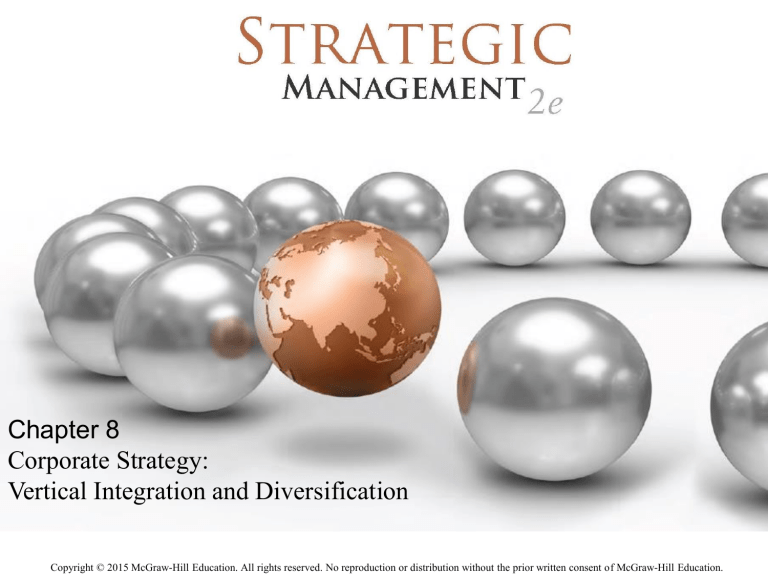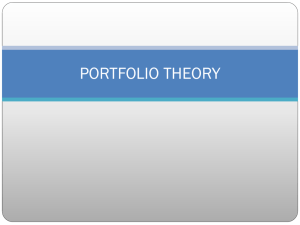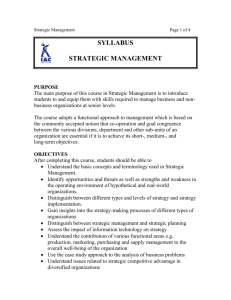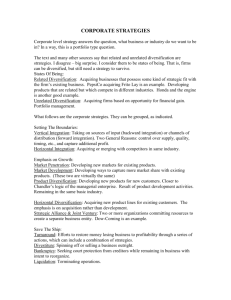
Chapter 8
Corporate Strategy:
Vertical Integration and Diversification
Copyright © 2015 McGraw-Hill Education. All rights reserved. No reproduction or distribution without the prior written consent of McGraw-Hill Education.
8-2
Chapter Outline
8.1 What Is Corporate Strategy?
8.2 The Boundaries of the Firm
• Firms vs. Markets: Make or Buy?
• Alternatives on the Make-or-Buy Continuum
8.3 Vertical Integration along the Industry Value Chain
• Types of Vertical Integration
8.4 Corporate Diversification: Expanding Beyond a Single Market
• Types of Corporate Diversification
• Leveraging Core Competencies for Corporate Diversification
• Corporate Diversification and Firm Performance
8.5 Implications for the Strategist
8-3
ChapterCase 8
Courtesy of GE Healthcare
Refocusing GE: A Future of Clean-Tech and Health Care?
In 2008, more than half of GE’s profits came from GE
Capital.
Global financial crisis hit the company hard.
• Stock price fell from $42.12 to $6.66 in 17 months!
GE launched two strategic initiatives:
1. Ecomagination − clean-tech focus
2. Healthymagination – increase access and reduce costs of health
care services
Also sold 51% of NBC to Comcast in 2011 and the rest in
2013.
8-4
8.3 Vertical Integration along the
Industry Value Chain
In what stages of the industry value chain should the
firm participate?
Vertical integration
• Ownership of its inputs, production, & outputs in the
value chain
• Vertical value chain
• Industry-level integration from upstream to downstream
Examples: cell phone industry value chain
• Many different industries and firms
8-5
Exhibit 8.5
HTC’s Backward and Forward
Integration along the Industry Value Chain in
the Smartphone Industry
8-6
Benefits and Risks of Vertical
Integration
SOME BENEFITS OF VERTICAL INTEGRATION
Securing critical supplies
Lowering costs & improving quality
Facilitating investments in specialized assets
SOME RISKS OF VERTICAL INTEGRATION
Increasing costs & reducing quality
Reducing flexibility
Increasing the potential for legal repercussions
8-7
8.4 Corporate Diversification:
Expanding Beyond a Single Market
SECOND CORPORATE STRATEGY QUESTION
Degrees of diversification
• Range of products and services a firm should offer
Ex: PepsiCo also owns Lay's & Quaker Oats, but sold off KFC
Differences in corporate strategy between KFC & Chick-fil-A
Diversification strategies
• Product diversification
Active in several different product categories
• Geographic diversification
Active in several different countries
• Product–market diversification
Active in a range of both products and countries
8-8
Types of Corporate Diversification
Single-business firm derives >95% from one business
Google revenues from online search
Dominant-business firm 70% to 95% from one business
Harley-Davidson yields 10% revenues from clothing
Related diversification strategy <70% from one business
• Related-constrained – leverage current competencies
ExxonMobil strategic move into natural gas
• Related-linked – share only limited links to current business
Amazon move into cloud computing, Kindle tablets, & video streaming
Unrelated diversification <70% and few if any links
among businesses (a conglomerate)
GE, LG, Tata
8-9
The U.S. Automobile Industry’s
Profit Pool
Strategy Highlight 8.2
The Tata Group: Integration at the Corporate Level
Tata Group of India founded in 1868 – uses unrelated
diversification
• Tea, hospitality, steel, IT, power, and automobiles
• 500,000 employees and $100 billion in annual revenues
Tata Motors
• The luxury division with the Jaguar and Land Rover brands
focused differentiation strategy for developed markets
• The Nano car division with the Tata Nano brand
Focused cost-leadership strategy for emerging markets
Targets non-consumers moving up from mopeds and bicycles
8-11
Exhibit 8.8 The Core
Competence-Market Matrix
8-12
Corporate Diversification and Firm
Performance
Does corporate diversification lead to superior
performance?
The critical question to ask:
• Are the individual businesses worth more under the
company’s management than if each were managed in
separate firms?
Research finds an inverted U-shaped relationship
• Type of diversification
• Overall firm performance
8-13
Exhibit 8.11 Restructuring the
Corporate Portfolio:
The Boston Consulting
Group Growth-Share Matrix
8-14
8.5 Implications for the Strategist
Effective corporate strategy helps to gain and sustain a
competitive advantage.
Corporate strategy needs to be dynamic over time.
• GE CEO Jeffrey Immelt formulated a new corporate
strategy in clean-tech and health care. (ChapterCase 8)
• Strategic positions of Nike and adidas another example
adidas founded in 1924 focused on athletic shoes
Integrated manufacturing model
Globalization led adidas to less integration and wider sports apparel
2013 − 40% shoes, 50% apparel, 10% equipment
Nike started in 1978 as a vertically disintegrated firm.
8-15
ChapterCase 8
Courtesy of GE Healthcare
Consider This…
• 2012 – GE split the energy business into three SBUs: Power
and Water; Oil and Gas; and Energy Management.
This move has both internal and external benefits.
• GE increasing its global footprint
International sales were 19% in 1980; to over 52% in 2012.
Tackling big problems isa strength for a conglomerate.
• India is seeking to replicate a “leap frog” approach in energy
similar to that used in telecommunications.
Challenges for firms based in developed economies
Need robust solutions yet very economical
8-16





